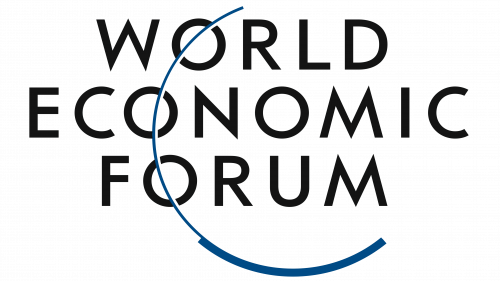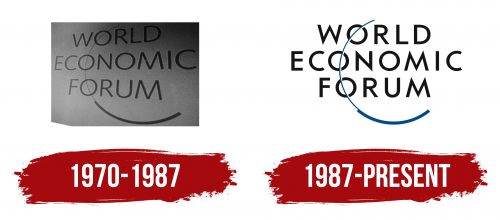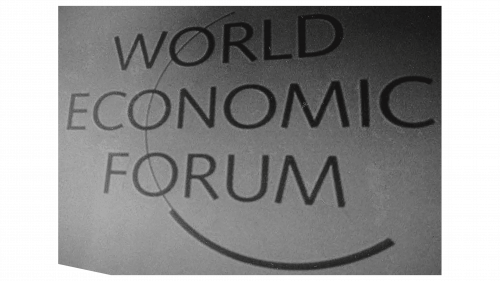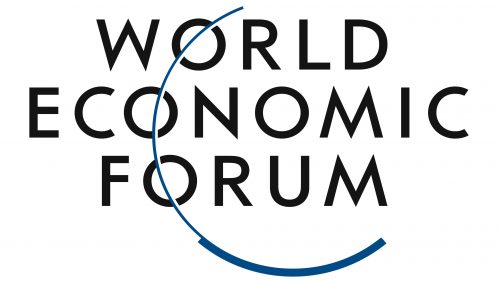The World Economic Forum logo symbolizes the broad influence and commitment to addressing global challenges related to economic development and the planet’s sustainability. The emblem embodies a business-like, comprehensive approach to important issues of global welfare, covering various levels and perspectives. Each symbol element conveys uniting efforts to achieve common goals, emphasizing openness and readiness for international cooperation. The logo carries an important message: only through joint efforts can solutions be found that promote development and maintain stability in the world.
World Economic Forum: Brand overview
The World Economic Forum (WEF) dates back to 1971, when Klaus Schwab, a professor of business administration at the University of Geneva, organized the first meeting of European business leaders in Davos, Switzerland. Initially called the European Management Forum, it attracted around 450 participants from 31 countries.
Schwab saw the need for a platform where business leaders could discuss global economic issues and business strategies. His vision went beyond traditional corporate management, aiming to examine business in a broader context of social responsibility.
After the oil crisis and the collapse of the Bretton Woods system in 1973, the forum expanded its focus to include political and economic issues, marking a significant shift. In 1974, political leaders were invited to attend the annual meetings, elevating the event’s influence by fostering dialogue between the public and private sectors.
In 1976, the organization began publishing the Global Competitiveness Report, which quickly became a respected source of information on national economic performance.
During the 1980s, the annual event’s influence grew substantially. In 1987, it was renamed to reflect its increasing global reach. The gathering began to play an important role in diplomacy, facilitating discussions between world leaders. A landmark moment came in 1988 when the forum helped avert a potential war between Turkey and Greece by facilitating a meeting between Turkish Prime Minister Turgut Özal and Greek Prime Minister Andreas Papandreou.
Following the end of the Cold War in the 1990s, attention shifted to emerging markets, and regional events were hosted in countries like China, India, and across South America. 1997, a leadership program was launched to identify and support young leaders under 40 from various sectors.
The forum’s global impact grew during the 2000s. In 2000, it helped establish the Global Alliance for Vaccines and Immunization (GAVI), a significant achievement in global health. To strengthen ties with international organizations and the U.S. business community, a second office was opened in New York in 2004.
The global financial crisis of 2008 marked a pivotal moment for the organization, which played a key role in discussions about reforming the global financial system and finding solutions to the crisis.
Throughout the 2010s, new initiatives were launched, including the Global Agenda initiative in 2012, which aimed to tackle major global challenges by collaborating with various stakeholders. In 2015, a new convention center opened in Davos, enhancing the facilities for the annual meetings. In 2016, the forum introduced the concept of the Fourth Industrial Revolution, a theme that has since shaped many of its discussions.
From 2020 to 2022, the organization adapted to the pandemic by shifting many activities to virtual platforms, where global leaders discussed strategies for economic recovery.
By 2023, the forum had established itself as one of the most influential international institutions, playing a crucial role in shaping the global agenda. Worldwide leaders, business executives, and experts convene in Davos each year to address urgent global challenges. The forum’s strategic partners, including major multinational companies like Microsoft, Boeing, Sun Microsystems, Coca-Cola, and Nestlé, pay the highest annual fees.
Throughout its history, the forum has demonstrated its ability to adapt to global changes, continuously expanding its reach and impact. From a small gathering of European business leaders to a global institution, it has become a key player in international politics and economics.
Meaning and History
What is World Economic Forum?
This well-known global organization brings together industry, government, academia, and civil society leaders internationally. The Swiss foundation is best known for its annual Davos meeting, which transformed the ski resort into a hub for international discussions and decision-making. However, its activities are not limited to major events—the foundation runs programs yearly to address critical global issues. The organization functions as a think tank, publishing research on various topics, including technological innovation and economic policy. The foundation’s unique ability to connect influential individuals from various fields fosters the exchange of ideas and the creation of alliances that shape the global agenda.
1970 – 1987
The World Economic Forum logo stands out for its resilience and stability. The straight black letters forming the name represent business acumen and competence in handling international affairs.
Each word in the logo is placed on its level, symbolizing the three key types of meetings organized by the Forum: the global summit in Davos, the summer session for young members—companies of global growth from developing economies, and regional meetings aimed at strengthening cooperation between key players in specific regions.
The World Economic Forum is a mediator and program developer, forming recommendations and facilitating meeting organizations. The organization’s main strength lies in its flexibility, ability to communicate with a wide range of participants, and quick responsiveness to global changes. This approach is reflected in the thin, elegant font, which adds lightness and adaptability to the logo.
A thin semicircle passes through the black letters, symbolizing the globe and emphasizing the global scale of the Forum’s activities. The World Economic Forum operates on all continents, and the organization’s primary mission is to create unified policies and global programs to stabilize and develop the world economy.
1987 – today
The main difference in the new emblem is the thicker and more confident lettering, emphasizing the growth in participants and the expansion of the organization’s functions. This design symbolizes the increasing authority and influence of the organization in international business and political spheres. The World Economic Forum logo looks modern and concise, highlighting the organization’s relevance and global impact. The straightforwardness and minimalism of the form emphasize the importance of the key issues the forum addresses. At the same time, the bold letters convey the scale of the organization, which holds a leading position in international politics and economics.
The logo is now oriented directly towards the viewer, creating a sense of open dialogue and a commitment to face-to-face conversation. This reflects the organization’s desire to convey its key messages and development trajectory to everyone. The numerous studies and initiatives the World Economic Forum conducted shape global directions to solve important world issues.
The primary color is black, symbolizing seriousness and stability. The clear lines of the letters convey the importance of the issues discussed at the forum concerning the global economy, climate, and politics. The font is strict and readable, broadcasting openness and readiness for dialogue on a global level.
An interesting detail of the logo is the blue semicircle that passes through the letters “O” in the words “World,” “Economic,” and “Forum.” This element symbolizes global connections, uniting people, ideas, and resources from all corners of the planet. The semicircle also resembles the Earth’s orbit, underscoring the global significance of the forum and its commitment to solving global problems. The blue color, associated with the planet and the clear sky, draws attention to sustainable development, environmental protection, and cooperation between countries for the common good.
Visually, the semicircle seems to embrace the text, creating an illusion of harmony and stability, which aligns with the forum’s mission — to support global security and improve the quality of life on the planet. The visual mark expresses dynamic development while remaining true to tradition. The lower part of the emblem is represented by a thickened stripe, creating a visually stable foundation and symbolizing the organization’s strength and reliability.
The World Economic Forum emblem successfully combines the ideas of global influence, responsibility, and cooperation in addressing global issues. The core mission of the World Economic Forum remains unchanged — ensuring global security, stability, and the growth of prosperity for all countries worldwide.






